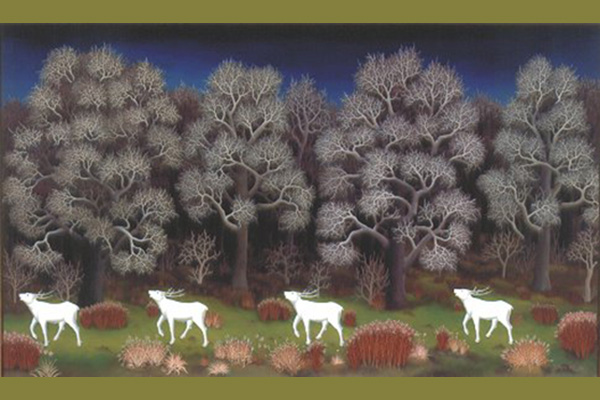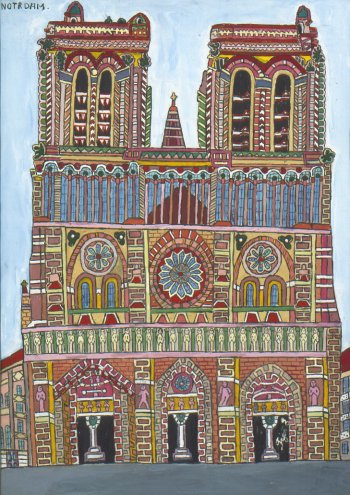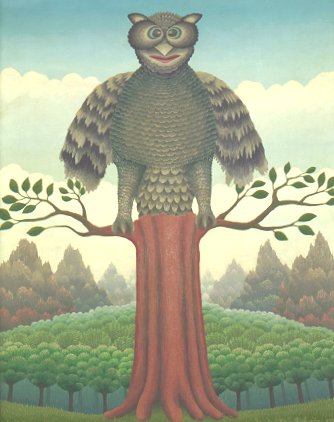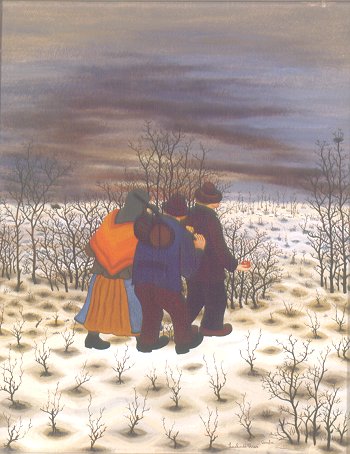


Ivan Generalic
Stag Wedding Party, 1959
Oil on glass
Lent by Josip Generalic
The Museum brings the largest exhibition ever to the United States-100
paintings-by some of the most imaginative self-taught artists in the world.
Croatian naïve art has been praised by scholars and critics and appreciated
by audiences worldwide, but has rarely been seen in this country. This
selection often works by ten of the most gifted self-taught artists in
Croatia will provide ample evidence of why such major museums as the Prado
in Madrid, the Tate Gallery in London, and the National Museum of Tokyo
have added examples from this tradition to their collections. So has the
Vatican.
 |
Notre Dame, c. 1962 Tempera on paper Lent by the Charlotte Zander Museum, Bönnigheim, Germany |
Scholars have referred to "the miracle of Croatian naïve art," and there is certainly an almost miraculous story behind its development. The "movement" began in the northern isolated Croatian village of Hlebine. These humble, minimally educated artists began to paint for their own enjoyment during the long, oppressive winters when they could not farm and were forced to spend most of their time indoors. Many of the paintings, then, reflect in part what they saw from their windows, but they frequently transformed these rural scenes into dreamscapes. They escaped their loneliness and isolation through wonderful flights of imagination.
On the whole, the paintings have vibrant colors; many were created
on glass giving them a particular brilliance. Religious imagery also figures
greatly in these paintings, reflecting Croatia's strongly Catholic tradition.
 |
The Owl, 1967 Oil on canvas Lent by the Charlotte Zander Museum, Bönnigheim, Germany |
The artists represented are leading figures in the development
of Croatian naïve art. They include Ivan Generalic (1914-1992), the
dean of what came to be known as the Hlebine School, another early painter
Mirko Virius, and Ivan's son Josip. The other artists are Emerik Feješ,
Dragan Gazi, Mijo Kovacic , Ivan Lackovic, Ivan Rabuzin, Matija Skurjeni,
and Ivan Vecenaj. While these names may be difficult for Americans to pronounce
and remember, the works will remain in viewers' memories long after the
show is over.
 |
The Wooing Party, 1963 Oil on glass Lent by the Croatian Museum of Naïve Art, Zagreb |
This exhibition comes at a fortuitous time in the history of Croatian culture. In 1991, Croatia declared itself an independent state under the leadership of President Franjo Tudjman, after the breakup of communist Yugoslavia. Actually, Croatian culture is quite ancient. Croatians arrived in the Balkan peninsula at the beginning of the seventh century and have developed a rich culture drawing on many civilizations.
Museum Director Michael Milkovich, a native of Croatia, has selected the paintings for the show, along with Director Franjo Mrzljak and Senior Curator Vladimir Crnkovi , both with the Croatian Museum of Naïve Art in Zagreb.
This exhibit is one of the most personally meaningful ones Mr.
Milkovich has organized during his long, distinguished career. The works
come from the Croatian Museum of Naïve Art, the Charlotte Zander Museum
in Bönnigheim, Germany, and the artists' private collections. Please
see the next Mosaic for more information on this spectacular show.
With its distinguished collection and distinctive special exhibitions, the Museum has been bringing the world to St. Petersburg for years. We hope you will join with us in presenting another major inter-national exhibition. The Fantastical World of Croatian Naïve Art is the first time that such a large sampling of work from this vibrant tradition has been presented in the United States. A beautifully illustrated catalogue will accompany the show. All of the works will be reproduced in color, and the 160-page catalogue will include an essay by Vladimir Crnkovic, the Senior Curator of the Croatian Museum of Naïve Art in Zagreb, and statements by Professor Franjo Mrzljak, its director, and Mr. Milkovich.
The Museum depends on its members and other friends to make its exhibitions possible. Those who make a contribution of $100 or more will be recognized in the catalogue. We have established the following giving categories: Angel ($25,000 and more), Benefactor ($10,000-24,999), Patron ($5,000-9,999), Sponsor ($1,000-4,999), Donor ($500-999), and Friend ($100-499).
The catalogue will be distributed to museums, universities, and libraries across the country and to selected institutions abroad. Please join with us in bringing this exciting exhibition to Florida and in publishing a striking, scholarly catalogue, making this extraordinary art available to a wider audience. Send your tax-deductible contribution to Gale Laubach, Administrative Assistant, Museum of Fine Arts, 255 Beach Drive N.E., St. Petersburg, FL 33701.
.
